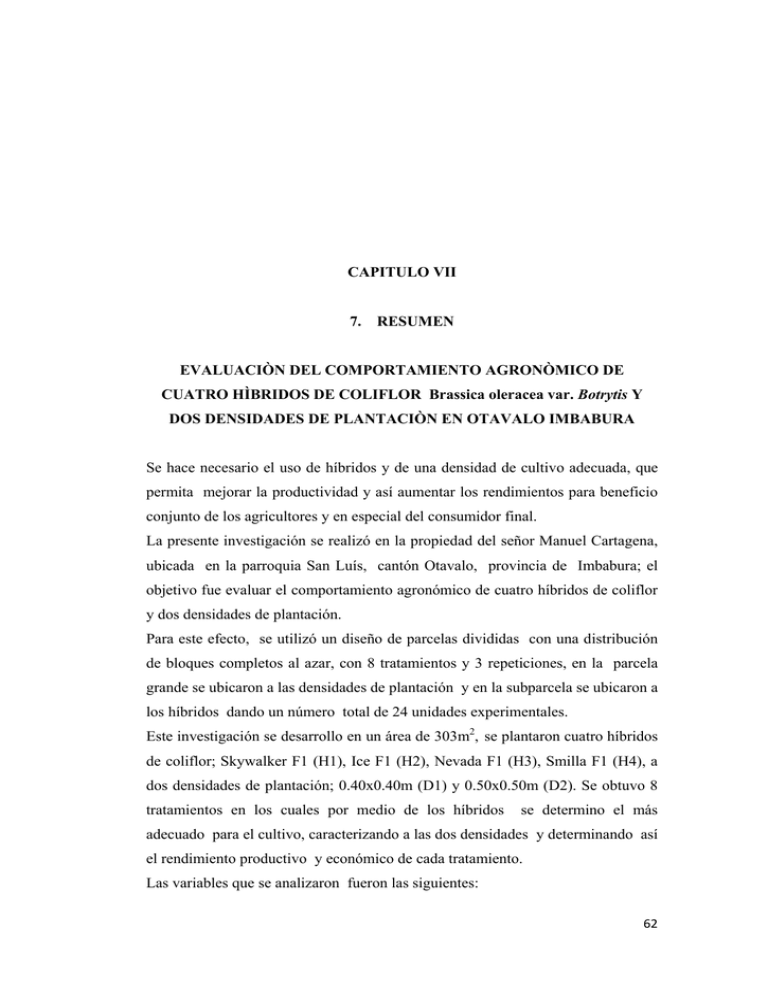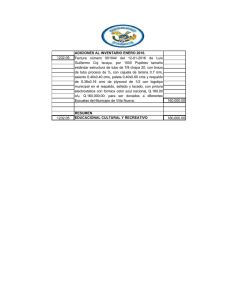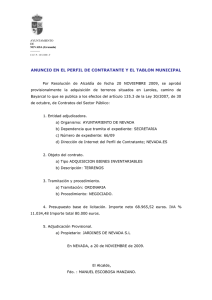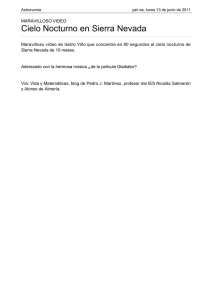03 AGP 83 CAPITULO VII,VIII,IX
Anuncio

CAPITULO VII 7. RESUMEN EVALUACIÒN DEL COMPORTAMIENTO AGRONÒMICO DE CUATRO HÌBRIDOS DE COLIFLOR Brassica oleracea var. Botrytis Y DOS DENSIDADES DE PLANTACIÒN EN OTAVALO IMBABURA Se hace necesario el uso de híbridos y de una densidad de cultivo adecuada, que permita mejorar la productividad y así aumentar los rendimientos para beneficio conjunto de los agricultores y en especial del consumidor final. La presente investigación se realizó en la propiedad del señor Manuel Cartagena, ubicada en la parroquia San Luís, cantón Otavalo, provincia de Imbabura; el objetivo fue evaluar el comportamiento agronómico de cuatro híbridos de coliflor y dos densidades de plantación. Para este efecto, se utilizó un diseño de parcelas divididas con una distribución de bloques completos al azar, con 8 tratamientos y 3 repeticiones, en la parcela grande se ubicaron a las densidades de plantación y en la subparcela se ubicaron a los híbridos dando un número total de 24 unidades experimentales. Este investigación se desarrollo en un área de 303m2, se plantaron cuatro híbridos de coliflor; Skywalker F1 (H1), Ice F1 (H2), Nevada F1 (H3), Smilla F1 (H4), a dos densidades de plantación; 0.40x0.40m (D1) y 0.50x0.50m (D2). Se obtuvo 8 tratamientos en los cuales por medio de los híbridos se determino el más adecuado para el cultivo, caracterizando a las dos densidades y determinando así el rendimiento productivo y económico de cada tratamiento. Las variables que se analizaron fueron las siguientes: 62 Peso de la pella a la cosecha, diámetro de la pella a la cosecha, grado de compactación de la pella, días a la cosecha, rendimiento y análisis económico. En el peso de la pella a la cosecha el mejor híbrido fue Nevada (H3), con un promedio de 856.1 g, la densidad de plantación con el mayor peso promedio con 810.4 g le corresponde a la densidad de 0.40x0.40m (D1). En la variable de diámetro de la pella resultó como mejor híbrido Nevada F1 (H3) con un diámetro de 17.27 cm., en tanto que la mejor densidad de plantación la obtuvo 0.40x0.40m (D1) alcanzando una media de 16.83cm. Para el grado de compactación de la pella, se destaca Nevada F1 (H3) que con un promedio de 48.70 g/cm, así mismo la densidad de plantación que influye es la de 0.40x0.40m (D1) con una media de 46.70 g/cm. En los días a la cosecha el híbrido Ice F1 (H2) con una media de 68.50 dìas, es el que presenta un desarrollo precoz, las densidades de plantación no fueron de significancia estadística para esta variable. Para el rendimiento el híbrido que mejores resultados obtuvo fue Nevada F1 (H3) con 27.38 Tm/ha y por consiguiente el más productivo. La mejor densidad resulto 0.40x0.40m (D1) con un rendimiento de 28.8 Tm/ha. El análisis económico indicó que el mejor tratamiento es el que corresponde al híbrido Skywalker F1 con la densidad de plantación de 040x0.40m (D1H1) con una relación B/C de USD 1,16. Los resultados obtenidos en esta investigación permiten establecer que el mejor material vegetativo que se adapta a las condiciones ambientales de Otavalo 63 Imbabura es el híbrido Nevada F1 (H3) a pesar de no ser muy precoz, presenta excelentes promedios con respecto a peso de la pella, diámetro de la pella a la cosecha, grado de compactación y rendimiento. Como la mejor densidad de plantación se determino a la densidad 0.40x0.40m (D1) ya que presenta la mejor respuesta a casi la totalidad de las variables planteadas en esta investigación, con excepción de la variable días a la cosecha por ser esta una característica del material vegetativo en estudio. 64 CHAPTER VIII 8. SUMMARY AGRONOMIST BEHAVIOR EVALUATION OF FOUR HYBRIDS OF CAULIFLOWER Brassica oleracea var. Botrytis AND TWO DENSITIES OF PLANTATION IN OTAVALO IMBABURA It is necessary to use hybrids and the right density of plantation that allows improving the productivity so the benefits for the farmers can increase as well as for the consumer. This research took place at Mr. Manuel Cartagena’s property, located in the San Luis parroquial, canton of Otavalo in the province of Imbabura. The objective was to evaluate the behavior of four hybrids of cauliflower and two densities of plantation. For doing this, it was used a design of divided parcels of land with a random distribution of complete blocks each with 3 repetitions of 8 treatments. The densities of plantation were placed on the big parcel of land, and the hybrids were placed on the small parcel of land giving as a result 24 experimental units. This investigation was fulfilled in an area of 303m2, four hybrids of cauliflower were grown: Skiwalker (H1), Ice F1 (H2), Nevada F1 (H3), Smilla F1 (H4); to two densities of plantation: 0, 40x0, 40m (D1) and 0, 50x0, 50m (D2). We got 8 treatments which through the use of hybrids, was determined which was the best variety for the crop and establishing the characteristics of the two densities and determining in this way the productivity and economic efficiency of each treatment. 65 The variables that were analyzed were: the weight of the pellet to the stock, diameter of the pellet to the stock, degree of compaction of the pellet, days until harvest, profits, and economic analysis. In the weight of the pellet to the stock, the best hybrid was Nevada (H3), with an average of 856,1g the density of plantation with the greatest weight average with 856,1g which the corresponding density of 0, 40x0, 40 m (D1). In the variable of the diameter of the pellet, it resulted as the best hybrid Nevada F1 (H3) with a diameter of 17.27 cm, and the best density of plantation which got 0.40x0.40m (D1) reaching a measurement of 16.83 cm. For the degree of compaction of the pellet, the best one is Nevada F1 (H3) with an average of 48,70g/cm; in the same way, the density of plantation that influence is 0.40x0.40 m (D1) with a measurement of 46, 70 g/cm. In the days of the crop variable, the hybrid Ice F1 (H2) with a media of 68,50 days shows an early development but the densities of plantation were not statistically significant for this variable. For the profits variable, the hybrid which better results got was Nevada F1 (H3) with 27, 38 Tm/ha and therefore the best productive one. The best density was 0, 40x0, 40 m (D1) with a profit of 28.8 Tm/ha. The economic analysis stated that the best treatment is which corresponds to Skywalwer F1 hybrid with the density of plantation of 0, 40x0, 40m (T1H1) with a relation B/C of USD 1.16. 66 The results obtained in this investigation allow establishing that the best vegetative material that it adapts to the environmental conditions of Otavalo Imbabura is the hybrid Nevada F1 (H3) in spite of the fact that it is not very precocious, it presents excellent averages in respect with the weight of the pellet, diameter of the pellet to the stock, degree of compaction and profits. As the best density of plantation was determined the density of 0,40x0,40 m (D1) since it shows the best response to almost all the variables established in this investigation, with the exception of the variable days to the crop for being this one a characteristic of the vegetative material being studied. 67 CAPÍTULO IX 9. BIBLIOGRAFIA 1. ANUARIO METEREOLÓGICO del INAMHÍ (2008). SIG-AGRO Ministerio de Agricultura y Ganadería Quito-Ecuador. Disponible en: 2. BAIXAULI. C (s/f). Características del cultivo coliflor y romanesco en España. Disponible en: ww.eumedia.es/articiüos/vr/Hortofrut/colifíor1junio.htm) 3. BEJO, (2006). Semillas orgánicas. Madrid (España). Disponible en: www. beio.es/Biológico 4. BOLEA, J. (1982). Cultivo de coles, coliflores y brúcolis. Barcelona (España). Sientes, p. 111-116,145-146. 5. CARBAJAL, M. y VELEZ, D. (1996). Estudio fenológico del brócoli, Quito (Ecuador). INAMHI. nacimiento precipitación, p. 3-4. 68 6. CASSERES, E. (1980). Producción de hortalizas. 3a ed. San José (Costa Rica): Centro Interamericano de Documentación e Información Agrícola, p. 129 177, 310. 7. III CENSO AGROPECUARIO EN EL ECUADOR, 2000, disponible en http://www. s ica. gov. ec. html. 8. COTR1NA, F. (1981). Cultivo de la coliflor, Hojas Divulgadoras (España). N° 21: 1-28. 9. CRIBOSEEDS. (s/f). QUITO (Ec). Coliflor Snowball Y - Improved. s.n.p. 10. DESDE EL SURCO. (2000). Como hacer abonos orgánicos. Quito (EC). s.e. p. 35. 11. EQUIPO DE EXPERTOS AGRÓNOMOS DVE. BARCELONA (ESPAÑA) (1995). Cómo cultivar el huerto con éxito. Barcelona, De Vecchi. p. 8788. 12. FACULTAD DE AGRONOMÍA E INGENIERÍA FORESTAL, SANTIAGO (CHILE). (2004). Hortalizas de estación fría. Disponible en: www.puc.cl/sw educ/hort049. 13. GARCÍA, R. (1952). Horticultura. Barcelona: Salvat. s..n..p. 14. GlACONII, V. (1955). Cultivo de hortalizas. 2a ed Santiago de Chile: Tipográfica Salesiana. p.162 69 15. GÓMEZ, J. (1986). Requerimientos ecológicos para algunos cultivos en el Ecuador. Quito, Ministerio de Agricultura y Ganadería. p. 26. 16. GUERRERO, T. (1993). Horticultura. Quito: Universidad Central del Ecuador, Facultad de Ciencias Agrícolas, p. 10-15. 17. HELMUTH, W. (2 000). Entomología agrícola del Ecuador. Quito. Abva -Yala. p. 225, 488. 18. HIGUITA, F. (1970). Horticultura, Bogotá (Colombia): Centro Nacional de Investigaciones Agropecuarias, p. 65. 19. HUME, W. (1971). Producción comercial de coliflores, coles de bruselas y otros cultivos afines. "Trad, del Inglés por Ángel Sánchez Gómez. Zaragoza (España). Acribia, p. 16-25 20. IDEA BOOKS. (s/f). Barcelona (España), Biblioteca de la agricultura. Barcelona, p 654-070. 21. JAPÓN, J. (1983). Cultivo extensivo de la coliflor. Hojas Divulgadoras. (España). N°7:23. 22. JARA, R (2005). Estimación de la superficie cosechada (ha). SIG-AGRO. Disponible en: www.sica.gov.ec. 23. KNOTT. (1957). LLandbook for vegetable growers. New York (USA), John Willey. p. 69. 70 24. KREUTER, M. (1994). Jardín y huerto biológicos. T'rad. M. Díaz, J. Ortíz, M. Ruíz, S. Sierra. Madrid, Mundi Prensa, p. 63-64. 157. 25. LIMONGELLI. J. (1979). El repollo y otras crucíferas de importancia en la huerta comercial. Buenos Aires. Hemisferio Sur. p.45- 53, 60-115. 26. LOBO, M. Programa de fitomejoramiento. In Jaramillo Vázquez, J.; Lobo Arias, M.; (cornp). Manual de hortalizas. Bogotá: Instituto Colombiano Agropecuario, p. 189-194. 27. MAINARDI, F. (2000). El cultivo biológico de hortalizas y frutales. Barcelona (España), p. 93-103.118-123. 28. NAMESNY. A. (1993). Post-recolección de hortalizas. Barcelona, Ediciones de Horticultura S. L. Reus. p. 302-309. 29. .NOVARTIS. Novartis seeds. s.n.t. híbridos 30. NUEZ, F. (1999). Colección de semillas de coliflor y bróculi. Madrid. Instituto Nacional de Investigación y Tecnología Agraria y Alimentaría, p. 5,13-18,23, 32,39. 31. PILLAJO, F. (1984). Proyecto piloto de producción de hortalizas en huertos demostrativos de unidades de salud familiares. Quito (Ecuador): Ministerio de Agricultura y Ganadería, p. 1 -9. 32. ROY AL SLUIS. s.f. Hoja técnica de brócoli, repollo brusselas, coliflor, s.n.t. 71 33. SANTILLAN, N. (2006). Línea de semillas y hortalizas. Disponible en: www.imporalaska. com/semillas. 34. SUQUILANDA, M. (1995). Hortalizas, manual para la producción orgánica. Quito (EC): Fundación de Desarrollo Agropecuario, p. 37-38. 35. TAMARO, D. (1968). Manual de horticultura. Trad . por Arturo Caballero. Barcelona, p. 164. 36. T1SCORNIA, J. (1984). Guía práctica y calendario para la huerta. Buenos Aire (Argentina): Albatros. p. 74-75, 108. 37. TURCHI, A. (1990). Guías de agricultura y ganadería. Guías prácticas de horticultura. 2a ed Barcelona (España): CEAC. P. 122-123. 72


